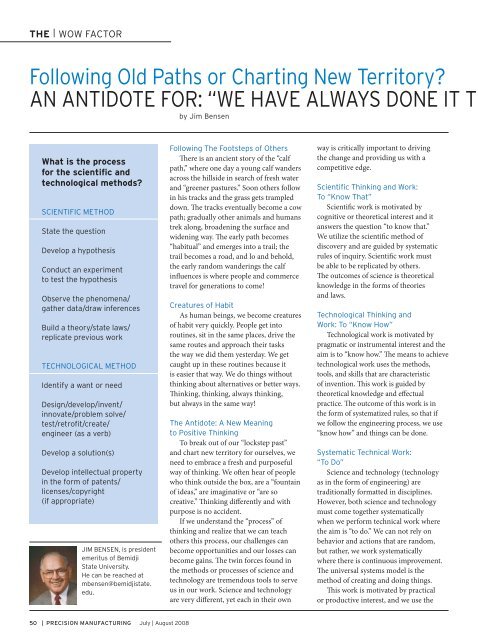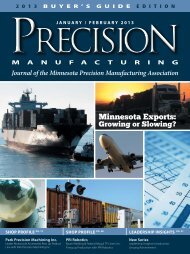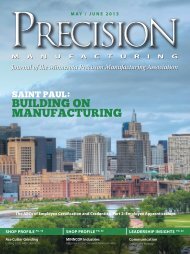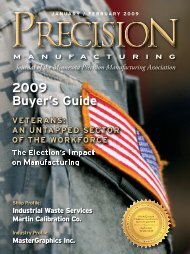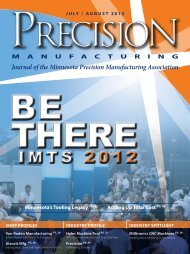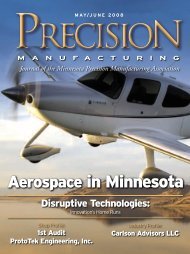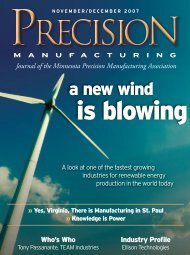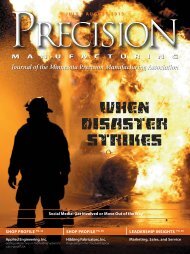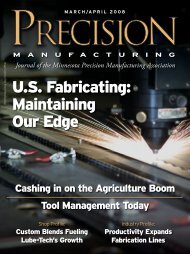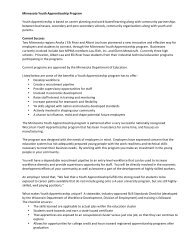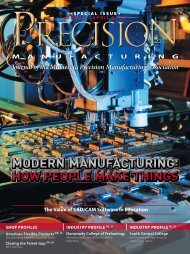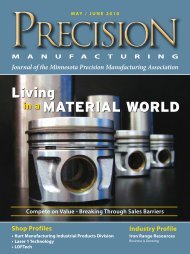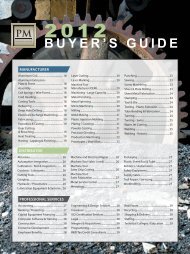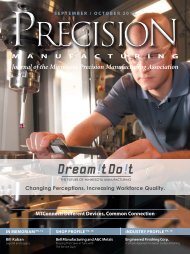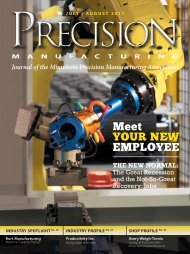July / August - Minnesota Precision Manufacturing Association
July / August - Minnesota Precision Manufacturing Association
July / August - Minnesota Precision Manufacturing Association
Create successful ePaper yourself
Turn your PDF publications into a flip-book with our unique Google optimized e-Paper software.
There is an ancient story of the “calf<br />
path,” where one day a young calf wanders<br />
across the hillside in search of fresh water<br />
and “greener pastures.” Soon others follow<br />
in his tracks and the grass gets trampled<br />
down. The tracks eventually become a cow<br />
path; gradually other animals and humans<br />
trek along, broadening the surface and<br />
widening way. The early path becomes<br />
“habitual” and emerges into a trail; the<br />
trail becomes a road, and lo and behold,<br />
the early random wanderings the calf<br />
influences is where people and commerce<br />
travel for generations to come!<br />
<br />
As human beings, we become creatures<br />
of habit very quickly. People get into<br />
routines, sit in the same places, drive the<br />
same routes and approach their tasks<br />
the way we did them yesterday. We get<br />
caught up in these routines because it<br />
is easier that way. We do things without<br />
thinking about alternatives or better ways.<br />
Thinking, thinking, always thinking,<br />
but always in the same way!<br />
<br />
<br />
To break out of our “lockstep past”<br />
and chart new territory for ourselves, we<br />
need to embrace a fresh and purposeful<br />
way of thinking. We often hear of people<br />
who think outside the box, are a “fountain<br />
of ideas,” are imaginative or “are so<br />
creative.” Thinking differently and with<br />
purpose is no accident.<br />
If we understand the “process” of<br />
thinking and realize that we can teach<br />
others this process, our challenges can<br />
become opportunities and our losses can<br />
become gains. The twin forces found in<br />
the methods or processes of science and<br />
technology are tremendous tools to serve<br />
us in our work. Science and technology<br />
are very different, yet each in their own<br />
way is critically important to driving<br />
the change and providing us with a<br />
competitive edge.<br />
<br />
<br />
Scientific work is motivated by<br />
cognitive or theoretical interest and it<br />
answers the question “to know that.”<br />
We utilize the scientific method of<br />
discovery and are guided by systematic<br />
rules of inquiry. Scientific work must<br />
be able to be replicated by others.<br />
The outcomes of science is theoretical<br />
knowledge in the forms of theories<br />
and laws.<br />
<br />
<br />
Technological work is motivated by<br />
pragmatic or instrumental interest and the<br />
aim is to “know how.” The means to achieve<br />
technological work uses the methods,<br />
tools, and skills that are characteristic<br />
of invention. This work is guided by<br />
theoretical knowledge and effectual<br />
practice. The outcome of this work is in<br />
the form of systematized rules, so that if<br />
we follow the engineering process, we use<br />
“know how” and things can be done.<br />
<br />
<br />
Science and technology (technology<br />
as in the form of engineering) are<br />
traditionally formatted in disciplines.<br />
However, both science and technology<br />
must come together systematically<br />
when we perform technical work where<br />
the aim is “to do.” We can not rely on<br />
behavior and actions that are random,<br />
but rather, we work systematically<br />
where there is continuous improvement.<br />
The universal systems model is the<br />
method of creating and doing things.<br />
This work is motivated by practical<br />
or productive interest, and we use the


